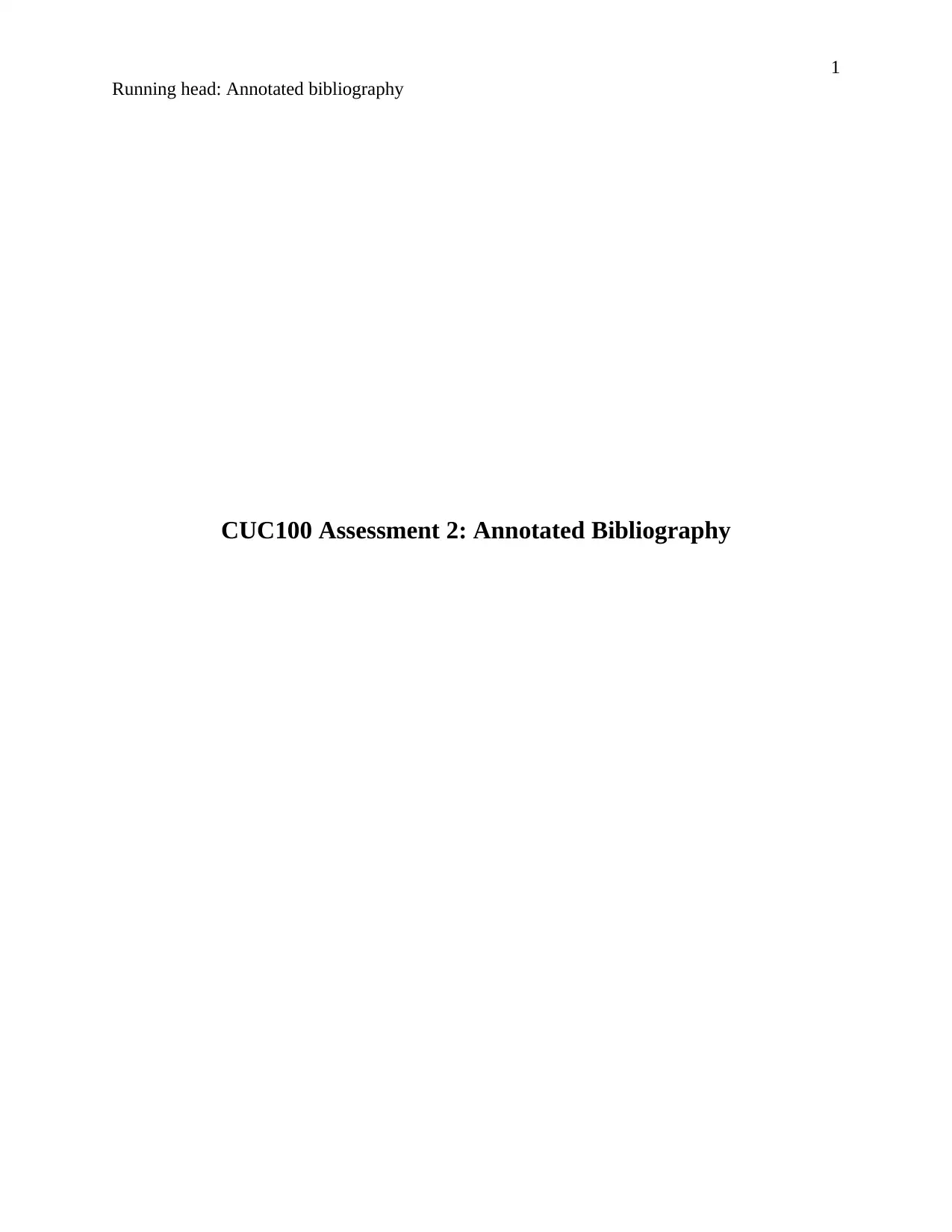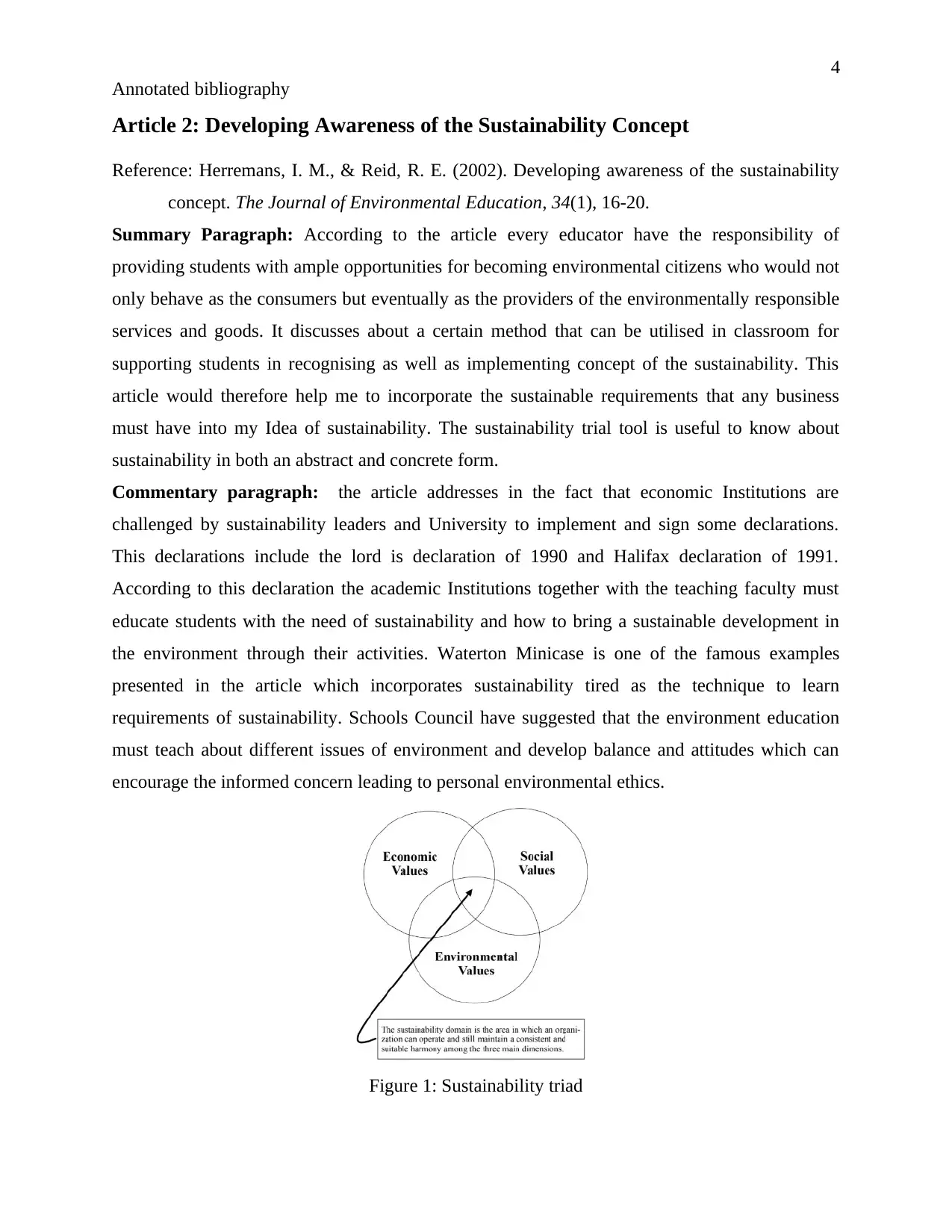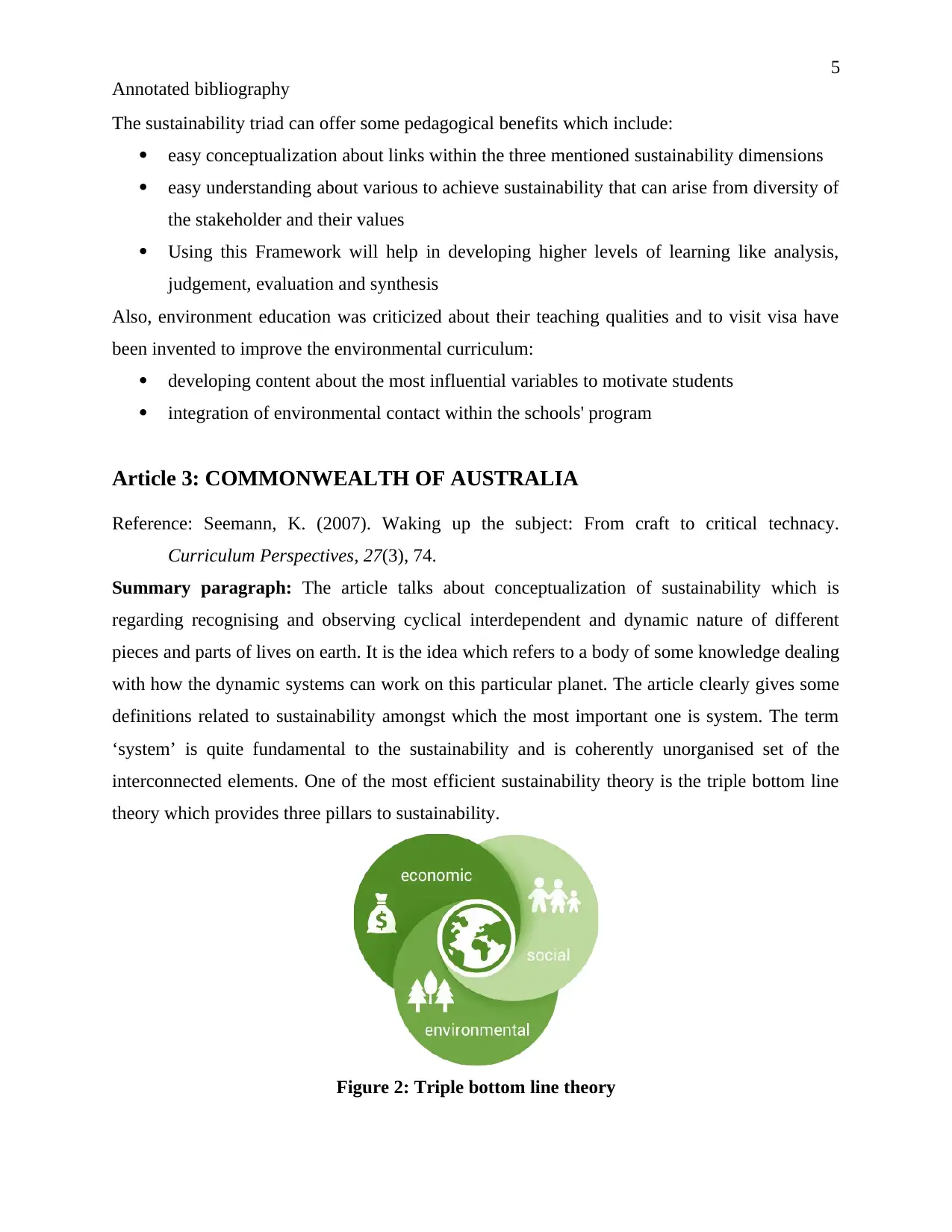CUC100 Assignment 2: Annotated Bibliography on Sustainability
VerifiedAdded on 2023/06/07
|6
|1098
|327
Annotated Bibliography
AI Summary
This annotated bibliography, prepared for CUC100, explores the multifaceted concept of sustainability, primarily within the context of Australia's mining industry. The bibliography comprises three articles. The first article examines the evolving landscape of mining in Western Australia, contrasting its historical environmental disruptions with contemporary sustainable practices, and highlighting the ongoing economic, environmental, and social challenges. The second article delves into the importance of environmental education and the sustainability triad, emphasizing the role of educators in fostering environmental citizenship and providing tools for understanding sustainability. The third article discusses the conceptualization of sustainability, focusing on the interconnectedness of life on earth and the triple bottom line theory that encompasses ecology and environment, economics, and social equity. Each article is summarized and critically analyzed, providing insights into the complex relationship between mining, sustainability, and environmental impact.

1
Running head: Annotated bibliography
CUC100 Assessment 2: Annotated Bibliography
Running head: Annotated bibliography
CUC100 Assessment 2: Annotated Bibliography
Paraphrase This Document
Need a fresh take? Get an instant paraphrase of this document with our AI Paraphraser

2
Annotated bibliography
Contents
Article 1: The mining boom and Western Australia’s changing landscape: Towards sustainability
or business as usual?........................................................................................................................3
Article 2: Developing Awareness of the Sustainability Concept....................................................4
Article 3: COMMONWEALTH OF AUSTRALIA........................................................................5
Annotated bibliography
Contents
Article 1: The mining boom and Western Australia’s changing landscape: Towards sustainability
or business as usual?........................................................................................................................3
Article 2: Developing Awareness of the Sustainability Concept....................................................4
Article 3: COMMONWEALTH OF AUSTRALIA........................................................................5

3
Annotated bibliography
Article 1: The mining boom and Western Australia’s changing landscape:
Towards sustainability or business as usual?
Reference 1: Brueckner, M., Durey, A., Mayes, R., & Pforr, C. (2013). The mining boom and
Western Australia’s changing landscape: Towards sustainability or business as usual?.
Rural Society, 22(2), 111-124.
Summary Paragraph: Public reputation and practices of mining have started to change over the
time. In ancient periods, operations of mining was condemned to be environmental and social
disruptive however today mining invest heavily behind sustainable and responsible business
practices. These practical and environmental support exchanges can be well witnessed in
international places and also in the Western Australia where mining sector achieved its maturity
and contributes to the economic condition of the country. The article therefore contains some
findings that suggest in spite of notice for the operational and attitudinal improvements within
industry economic environmental and social problems remain. These issues need attention of
Government and business who will be able to assure long term development of sustainability,
place and people.
Commentary paragraph: The selected area for the project is sustainability and its development
internationally through different sectors. Article states that in ancient times mining sector used to
have the checkout performance related to management of environmental and social obligations.
The article also portrays about the benefits received from the mining sector and how it
contributes to the economic improvement of Australia especially Western Australia. Almost
1050 mining sites, 170 processing mineral plants and more than 70 gas and oil field are operating
in Western Australia. All of these together contributes to 29% of the entire Gross Domestic
Product of the country. Indigenous people rights have been also snatched due to the mining
activities. Mining impacts biodiversity water reservoir depression as well as cumulative impacts
of the extensive infrastructure involving ports and roads which impacts not only the indigenous
and local communities but even the residence of Western Australia in a broader away.
Annotated bibliography
Article 1: The mining boom and Western Australia’s changing landscape:
Towards sustainability or business as usual?
Reference 1: Brueckner, M., Durey, A., Mayes, R., & Pforr, C. (2013). The mining boom and
Western Australia’s changing landscape: Towards sustainability or business as usual?.
Rural Society, 22(2), 111-124.
Summary Paragraph: Public reputation and practices of mining have started to change over the
time. In ancient periods, operations of mining was condemned to be environmental and social
disruptive however today mining invest heavily behind sustainable and responsible business
practices. These practical and environmental support exchanges can be well witnessed in
international places and also in the Western Australia where mining sector achieved its maturity
and contributes to the economic condition of the country. The article therefore contains some
findings that suggest in spite of notice for the operational and attitudinal improvements within
industry economic environmental and social problems remain. These issues need attention of
Government and business who will be able to assure long term development of sustainability,
place and people.
Commentary paragraph: The selected area for the project is sustainability and its development
internationally through different sectors. Article states that in ancient times mining sector used to
have the checkout performance related to management of environmental and social obligations.
The article also portrays about the benefits received from the mining sector and how it
contributes to the economic improvement of Australia especially Western Australia. Almost
1050 mining sites, 170 processing mineral plants and more than 70 gas and oil field are operating
in Western Australia. All of these together contributes to 29% of the entire Gross Domestic
Product of the country. Indigenous people rights have been also snatched due to the mining
activities. Mining impacts biodiversity water reservoir depression as well as cumulative impacts
of the extensive infrastructure involving ports and roads which impacts not only the indigenous
and local communities but even the residence of Western Australia in a broader away.
⊘ This is a preview!⊘
Do you want full access?
Subscribe today to unlock all pages.

Trusted by 1+ million students worldwide

4
Annotated bibliography
Article 2: Developing Awareness of the Sustainability Concept
Reference: Herremans, I. M., & Reid, R. E. (2002). Developing awareness of the sustainability
concept. The Journal of Environmental Education, 34(1), 16-20.
Summary Paragraph: According to the article every educator have the responsibility of
providing students with ample opportunities for becoming environmental citizens who would not
only behave as the consumers but eventually as the providers of the environmentally responsible
services and goods. It discusses about a certain method that can be utilised in classroom for
supporting students in recognising as well as implementing concept of the sustainability. This
article would therefore help me to incorporate the sustainable requirements that any business
must have into my Idea of sustainability. The sustainability trial tool is useful to know about
sustainability in both an abstract and concrete form.
Commentary paragraph: the article addresses in the fact that economic Institutions are
challenged by sustainability leaders and University to implement and sign some declarations.
This declarations include the lord is declaration of 1990 and Halifax declaration of 1991.
According to this declaration the academic Institutions together with the teaching faculty must
educate students with the need of sustainability and how to bring a sustainable development in
the environment through their activities. Waterton Minicase is one of the famous examples
presented in the article which incorporates sustainability tired as the technique to learn
requirements of sustainability. Schools Council have suggested that the environment education
must teach about different issues of environment and develop balance and attitudes which can
encourage the informed concern leading to personal environmental ethics.
Figure 1: Sustainability triad
Annotated bibliography
Article 2: Developing Awareness of the Sustainability Concept
Reference: Herremans, I. M., & Reid, R. E. (2002). Developing awareness of the sustainability
concept. The Journal of Environmental Education, 34(1), 16-20.
Summary Paragraph: According to the article every educator have the responsibility of
providing students with ample opportunities for becoming environmental citizens who would not
only behave as the consumers but eventually as the providers of the environmentally responsible
services and goods. It discusses about a certain method that can be utilised in classroom for
supporting students in recognising as well as implementing concept of the sustainability. This
article would therefore help me to incorporate the sustainable requirements that any business
must have into my Idea of sustainability. The sustainability trial tool is useful to know about
sustainability in both an abstract and concrete form.
Commentary paragraph: the article addresses in the fact that economic Institutions are
challenged by sustainability leaders and University to implement and sign some declarations.
This declarations include the lord is declaration of 1990 and Halifax declaration of 1991.
According to this declaration the academic Institutions together with the teaching faculty must
educate students with the need of sustainability and how to bring a sustainable development in
the environment through their activities. Waterton Minicase is one of the famous examples
presented in the article which incorporates sustainability tired as the technique to learn
requirements of sustainability. Schools Council have suggested that the environment education
must teach about different issues of environment and develop balance and attitudes which can
encourage the informed concern leading to personal environmental ethics.
Figure 1: Sustainability triad
Paraphrase This Document
Need a fresh take? Get an instant paraphrase of this document with our AI Paraphraser

5
Annotated bibliography
The sustainability triad can offer some pedagogical benefits which include:
easy conceptualization about links within the three mentioned sustainability dimensions
easy understanding about various to achieve sustainability that can arise from diversity of
the stakeholder and their values
Using this Framework will help in developing higher levels of learning like analysis,
judgement, evaluation and synthesis
Also, environment education was criticized about their teaching qualities and to visit visa have
been invented to improve the environmental curriculum:
developing content about the most influential variables to motivate students
integration of environmental contact within the schools' program
Article 3: COMMONWEALTH OF AUSTRALIA
Reference: Seemann, K. (2007). Waking up the subject: From craft to critical technacy.
Curriculum Perspectives, 27(3), 74.
Summary paragraph: The article talks about conceptualization of sustainability which is
regarding recognising and observing cyclical interdependent and dynamic nature of different
pieces and parts of lives on earth. It is the idea which refers to a body of some knowledge dealing
with how the dynamic systems can work on this particular planet. The article clearly gives some
definitions related to sustainability amongst which the most important one is system. The term
‘system’ is quite fundamental to the sustainability and is coherently unorganised set of the
interconnected elements. One of the most efficient sustainability theory is the triple bottom line
theory which provides three pillars to sustainability.
Figure 2: Triple bottom line theory
Annotated bibliography
The sustainability triad can offer some pedagogical benefits which include:
easy conceptualization about links within the three mentioned sustainability dimensions
easy understanding about various to achieve sustainability that can arise from diversity of
the stakeholder and their values
Using this Framework will help in developing higher levels of learning like analysis,
judgement, evaluation and synthesis
Also, environment education was criticized about their teaching qualities and to visit visa have
been invented to improve the environmental curriculum:
developing content about the most influential variables to motivate students
integration of environmental contact within the schools' program
Article 3: COMMONWEALTH OF AUSTRALIA
Reference: Seemann, K. (2007). Waking up the subject: From craft to critical technacy.
Curriculum Perspectives, 27(3), 74.
Summary paragraph: The article talks about conceptualization of sustainability which is
regarding recognising and observing cyclical interdependent and dynamic nature of different
pieces and parts of lives on earth. It is the idea which refers to a body of some knowledge dealing
with how the dynamic systems can work on this particular planet. The article clearly gives some
definitions related to sustainability amongst which the most important one is system. The term
‘system’ is quite fundamental to the sustainability and is coherently unorganised set of the
interconnected elements. One of the most efficient sustainability theory is the triple bottom line
theory which provides three pillars to sustainability.
Figure 2: Triple bottom line theory

6
Annotated bibliography
Commentary paragraph: Sustainability is related to a particular form of the human and
economic activity as well as culture not leading to any environmental degradation. In the recent
era, planners and scientists already started to realise that as the planet is encountering too many
problems of health poverty resource depletion overpopulation water and food scarcity and others
therefore a theory is needed to guide everyone in a definite path. Hammer & Pivo (2017)
addresses that first ‘E’ represents Ecology and environment, second ‘E’ courses economics and
third ‘E’ shows equity or equality of social equity.
Annotated bibliography
Commentary paragraph: Sustainability is related to a particular form of the human and
economic activity as well as culture not leading to any environmental degradation. In the recent
era, planners and scientists already started to realise that as the planet is encountering too many
problems of health poverty resource depletion overpopulation water and food scarcity and others
therefore a theory is needed to guide everyone in a definite path. Hammer & Pivo (2017)
addresses that first ‘E’ represents Ecology and environment, second ‘E’ courses economics and
third ‘E’ shows equity or equality of social equity.
⊘ This is a preview!⊘
Do you want full access?
Subscribe today to unlock all pages.

Trusted by 1+ million students worldwide
1 out of 6
Related Documents
Your All-in-One AI-Powered Toolkit for Academic Success.
+13062052269
info@desklib.com
Available 24*7 on WhatsApp / Email
![[object Object]](/_next/static/media/star-bottom.7253800d.svg)
Unlock your academic potential
Copyright © 2020–2025 A2Z Services. All Rights Reserved. Developed and managed by ZUCOL.





